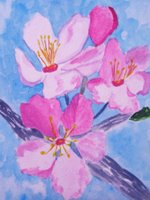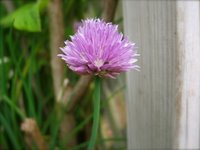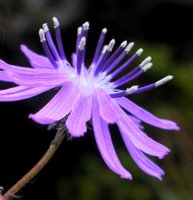C
Its nice to see the common and wild beauties making their place in the fest! The garden would only be a whole lot lovelier with more flowers pouring in! If you know of fellow bloggers who paint, sketch, "shoot" these petalled wonders,please spread the word!
These are the entries for the third letter 'C'.
CRAB APPLE BLOOMS by Nature and Me

Crab Apple Blooms are abundantly found in the USA in hues of pearly white, delicate pink and rich red. Crab apple trees are grown for ornamental purposes because of their beautiful flowers and fruits. During Spring these trees bloom in delicate colours. The unopened buds may be in one colour, but may bloom in other hues. Even as the flowers fade these trees look rich and colourful. Flowers are classified as single (five petals), semi-double (six-ten petals), or double (more than 10 petals). During autumn, the falling leaves of these trees transform into beautiful colours. These trees are used as pollenizers in apple orchards where they bloom along with the apple trees.Crab Apple flower essence is used as a natural remedy to help alleviate feelings of self-hatred and uncleanliness. It is used in the treatment for facial skin rashes. Also found to be helpful during fasting periods.
(Source for note: wikepedia; treehelp.com and about.com)
CANADA THISTLE by Manisha

This flower is only about an inch in height and even less in width. It was like a blur of color on the wet ground in Morrison, Colorado. Morrison is about 8000ft in altitude. The roots of the Canada thistle can spread more than 15 feet horizontally and its roots may grow into the soil anywhere from 6 to 15 feet deep.
Unlike the Buffalo Bur which tosses its spiny seeds into the path of all that may trod that way, the Canada thistle a creeping perennial that reproduces from vegetative buds in its root system. Roots and shoots can give rise to new plants. That's not to say that it does not produce seeds. This picture was taken towards the end of September.It looked like it was done flowering and already producing seed.
It can produce between 1000 to 1500 seeds per flowering shoot and seeds are responsible for long distance dispersal. The feathery pappus helps disperse the seeds. However it is known to fall off leaving the seed attached to the plant, requiring other modes of dispersal. Seedlings grow slower and are subject to competition from other weeds especially as they are not backed by an extensive root system. Nevertheless, its seed should not be underestimated as it can remain viable in the soil for 20 years. The deeper it is buried, the longer it is viable.
Canada thistle has spread throughout the US except the south-eastern region. In Colorado, it is found in the plains and foothills, flowering from July to September. It is classified as a noxious weed.
References: Colorado State University Cooperative Extension
Guide to Colorado Wildflowers Vol 1 Plains & Foothills and Guide to Colorado Wildflowers Vol 2.
Plains & Foothills and Guide to Colorado Wildflowers Vol 2.
CHIVES by Giniann

Chives are abundant in during spring and summer. They have small purple heads and have a lot of oniony flavor. Some say chives and roses grow well together and I think this is true.The chives under the roses flourish much more than the ones that are standing alone.
CICERBITA by Anita

Cicerbita is a low growing alpine wildflower from the Aster family. The sun-loving herbacious plant with a mounding habit produces clusters of blue-mauve flowers high above. Flowers from July-Sept. Local people use the plant to treat headaches. It is also used in Chinese medicine.
Photographed in the Valley of Flowers and nearby areas (Nanda Devi Biosphere Reserve), Chamoli district, Garhwal (Uttaranchal).
COSMOS by Sree

Also called the Mexican Aster, these flowers are so light and delicate they sway like grass in the wind, almost reminding one of dandelions! They belong to the 'Asteraceae' family, they grow up to 3.2 metres in height. The flower color varies between species, most common ones being yellow, orange, purple and white

3 comments:
Wow..thats a lovely list of flowers Sree. I hardly knew any of the flowers. Good job :).
Thanks Shilpa! Great to know ur visiting and enjoying the entries:)
Great to see these lovely flowers. Looks like the choice of "C" flowers has been more on the violet and lavender shades. Well done, Sree, Manisha, Giniann & Anita.
Post a Comment